Christmas programs
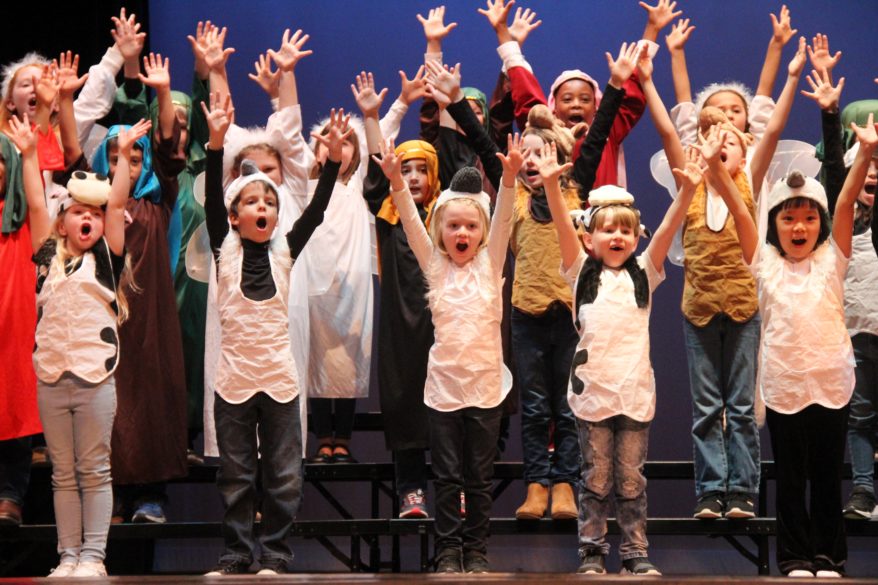
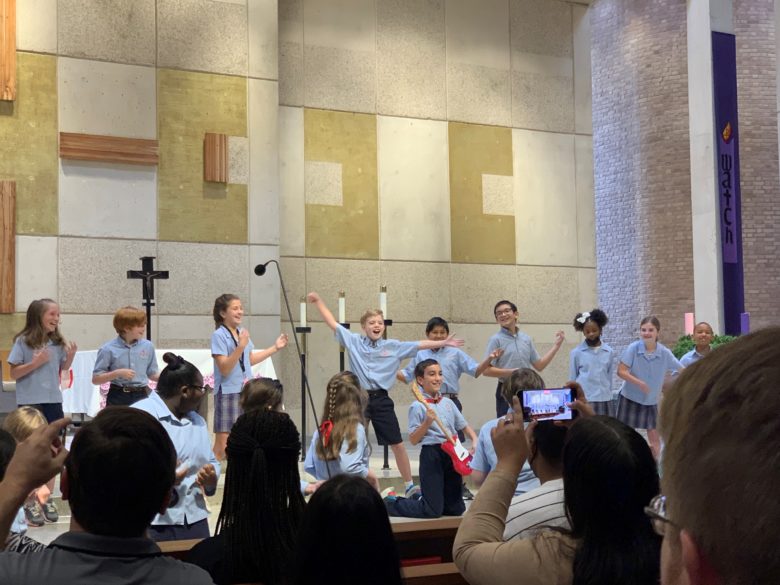

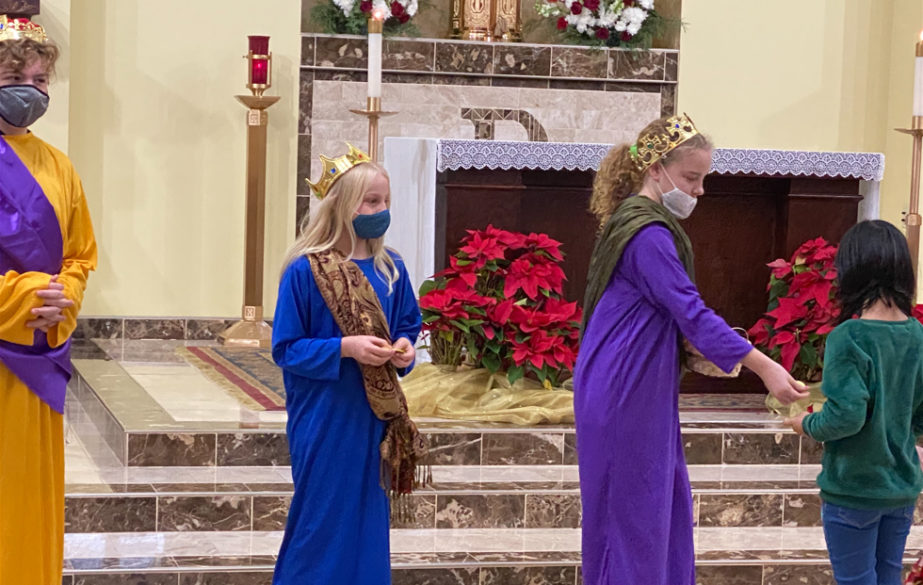
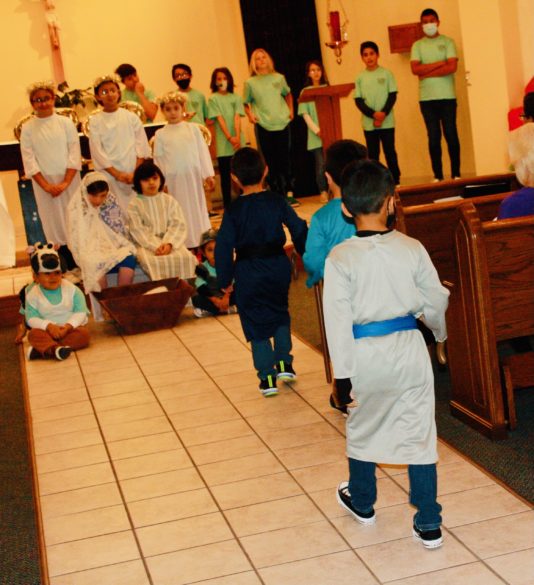
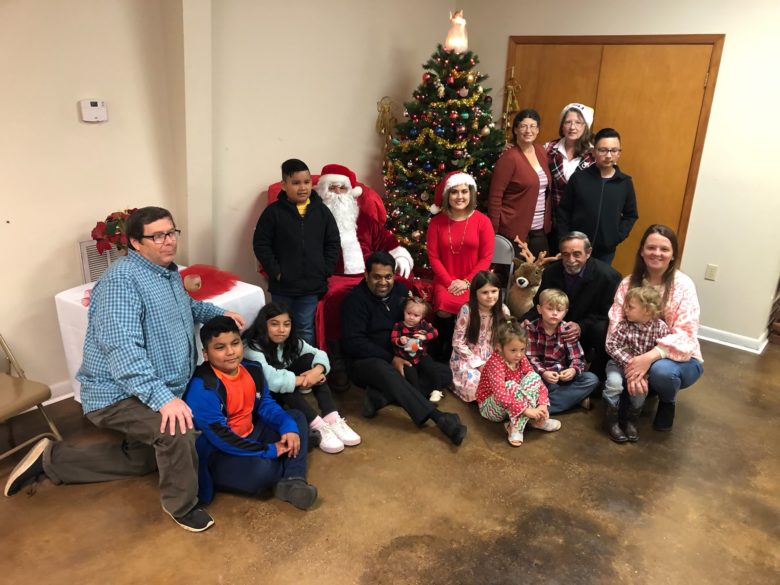

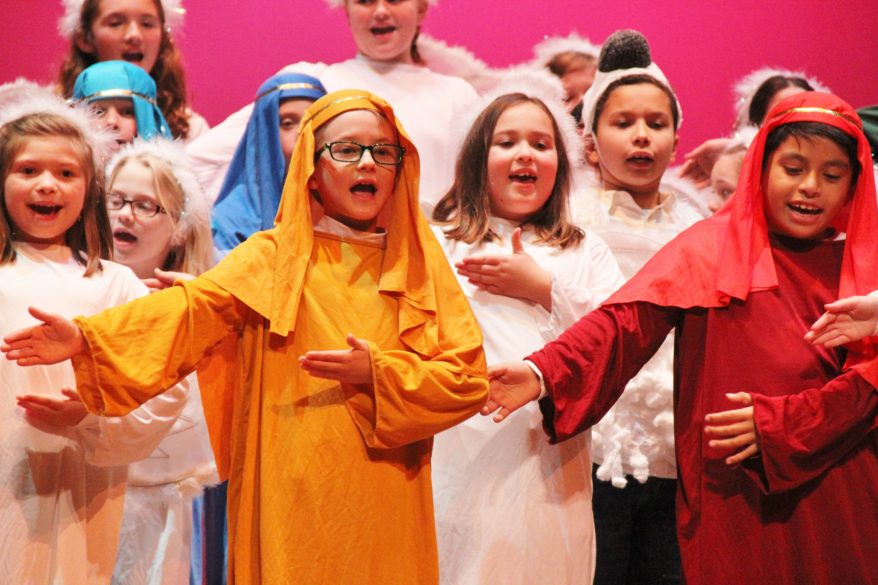


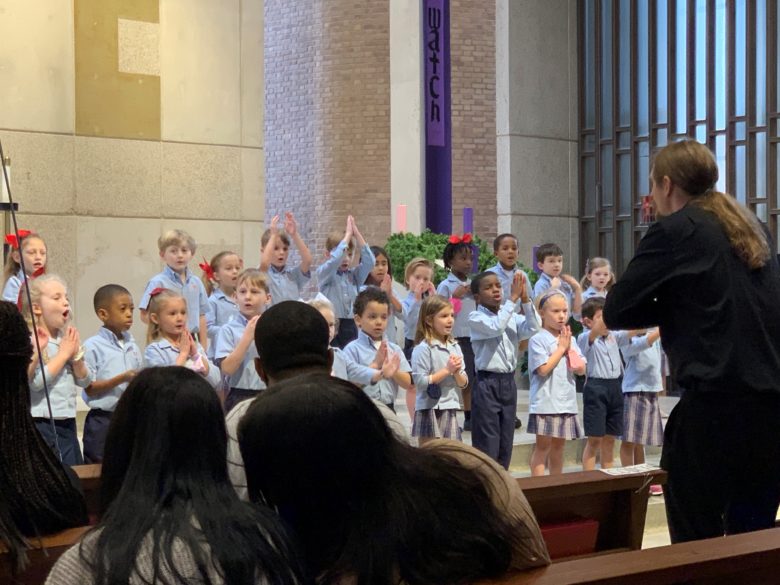
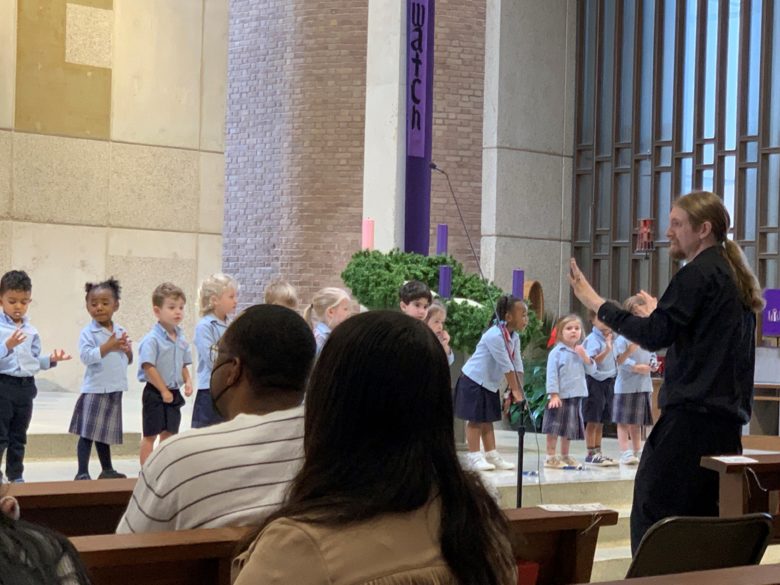




By Bishop Joseph R. Kopacz, D.D.
This past weekend we celebrated the Baptism of the Lord, the culmination of the Christmas season when the voice of our loving God resounded over the Jordan River after the baptism of his beloved Son who stood as one with his Father in heaven, bathed in the light of the hovering Holy Spirit. In that moment at the outset of Jesus’ public ministry, the loving unity of the Holy Trinity was proclaimed for all to hear.
Indeed, “God is love.” God the Father’s voice was the reassurance for all of the voices of the patriarchs and prophets, kings and suffering servants yearning for the Messiah over centuries. When the fullness of time unfolded, we heard the voices of the angels, shepherds and magi, the testimony of Matthew, Mark, Luke and John our beloved evangelists, and finally the testimony of John the Baptist, “behold the Lamb of God.”
Through faith and baptism, we are center stage in this divine drama. On the one hand this is largely evident when we raise up our voices in prayer, especially at Mass. When we choose to keep holy the “Lord’s Day” and gather in our churches as the Body of Christ, by God’s grace; we can recognize that we too are God’s beloved children, sisters and brothers in Jesus Christ, and temples of the Holy Spirit.
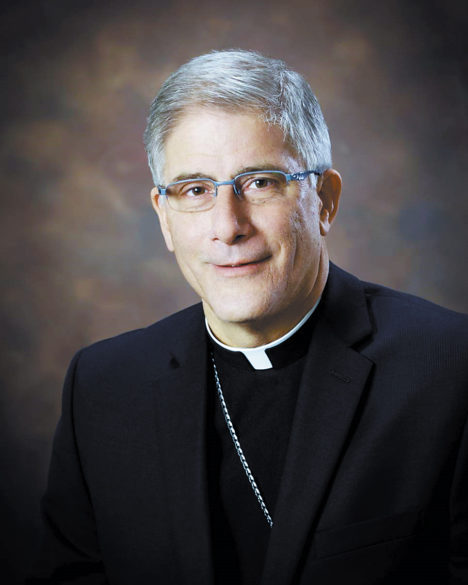
Remember the Lord’s assurance, that “the least born into the Kingdom of Heaven is greater than John the Baptist” and all who preceded him. The heavens were opened at the moment of Jesus’ baptism and remain permanently so in his death and resurrection so that the glory of God will shine forever on the face of Jesus Christ.
The star of faith enlightens our minds and hearts to know that love is our origin, love is our constant calling, and love is our fulfillment in heaven. The church by its very nature is the sacrament of salvation pointing the way to the heavens for all the world to see.
On the other hand, standing upon the cornerstone of faith in the divine drama, all the baptized, grafted onto to the vine are intended, by God’s design and grace, to live as God’s beloved in the world. The church throughout the world and on the local level is a living body where the least, as St. Paul eloquently wrote, are given special attention. Our faith in Jesus Christ is deeply personal and at the same time, never individualistic. Grafted on the vine of Jesus Christ, we are members of his body with different gifts, ministries and works for the common good beginning at home, in the church and in the world.
As you turn the pages of this edition of the Mississippi Catholic, I invite you to do so through the lens of our unity with the Holy Trinity and the bond that is established with one another through faith and baptism. For example, the Catholic Service Appeal is very balanced in its structure and purpose. Each year your generosity strengthens the Body of Christ throughout the Diocese of Jackson through many ministries, while also serving many on the margins of our communities through Catholic Charities who may never be able reciprocate in turn. Thus, our Service Appeal is genuinely Catholic.
The Synod on Synodality that is well underway in the Diocese of Jackson and in the church throughout the world is an extraordinary way to raise up our voices in prayer and dialogue. Although gatherings will occur in our parishes and other ministries at different times throughout February, the prayer and scriptures passages that guide these encounters will be the same for everyone, a visible sign of the unity that the Lord intends, and an opportunity to strengthen this bond under the hovering presence of the Holy Spirit and the loving gaze of our God.
Lastly, we can understand the annual diocesan report through the lens of this bond of unity. There are many moving parts in a complex organization that must be managed, and the Diocese of Jackson is no different in this respect. Yet, on the deeper level we pray to never forget who we are so that all our daily labor in support of our ministries is not a matter of maintenance, but truly of mission.
We are God’s children now, members of the body of the Beloved Son of God, encouraging one another to be fully alive with the mind and heart of Jesus Christ. May our voices and actions point the way for our struggling and suffering world.
All that we do as the Catholic Diocese of Jackson is the work of our faith and baptism in the power of the Holy Trinity.
Por Obispo Joseph R. Kopacz, D.D.
Este fin de semana pasado celebramos el Bautismo del Señor, la culminación de la temporada navideña, momento en que resonó la voz de nuestro amoroso Dios sobre el río Jordán; después del bautismo de su amado Hijo, quien se mantuvo como uno con su Padre en el cielo, bañado de la luz del Espíritu Santo que revoloteaba. Al comienzo del ministerio público de Jesús, se proclamó en ese momento para que todos la escucharan la unidad amorosa de la Santísima Trinidad.
De hecho, “Dios es amor” la voz de Dios Padre fue la promesa consoladora de todas las voces de los patriarcas, profetas, reyes y siervos sufrientes que anhelaban al Mesías durante siglos. Cuando la plenitud de los tiempos se desplegó, escuchamos las voces de los ángeles, pastores y Reyes Magos, el testimonio nuestros amados evangelistas: Mateo, Marcos, Lucas y Juan y finalmente el testimonio de Juan el Bautista al proclamar “He aquí el Cordero de Dios.”
A través de la fe y el bautismo, somos el centro del escenario en este drama divino. Por un lado, evidentemente, cuando elevamos nuestras voces en oración, especialmente en la Misa. Cuando elegimos santificar el “Día del Señor” y reunirnos en nuestras iglesias como el Cuerpo de Cristo, por la gracia de Dios; podemos reconocer que nosotros también somos hijos amados de Dios, hermanas y hermanos en Jesucristo, y templos del Espíritu Santo.

Recuerde que el Señor asegura que “el pequeño nacido en el Reino de los Cielos es mayor que Juan el Bautista” y todos los que lo precedieron. Los cielos fueron abiertos en el momento del bautismo de Jesús y permanecen permanentemente así, en su muerte y resurrección, para que la gloria de Dios resplandezca para siempre en el rostro de Jesucristo.
La estrella de la fe ilumina nuestras mentes y corazones para saber que el amor es nuestro origen, el amor es nuestro llamado constante y el amor es nuestro cumplimiento en el cielo. La iglesia, por su propia naturaleza, es el sacramento de la salvación que señala el camino a los cielos para que todo el mundo lo vea.
Por otra parte, sobre la piedra angular de la fe en el drama divino, todos los bautizados, injertados en la vid, están destinados, por designio y gracia de Dios, a vivir como amados de Dios en el mundo. La iglesia en todo el mundo y a nivel local, es un cuerpo vivo donde los últimos, como escribió elocuentemente San Pablo, reciben una atención especial. Nuestra fe en Jesucristo es profundamente personal y, al mismo tiempo, nunca es individualista. Injertados en la vid de Jesucristo, somos miembros de su cuerpo con diversos dones, ministerios y obras para el bien común, comenzando en el hogar, en la iglesia y en el mundo.
Al pasar las páginas de esta edición del Mississippi Catholic, los invito a hacerlo a través del lente de nuestra unidad con la Santísima Trinidad y el vínculo que se establece entre nosotros a través de la fe y el bautismo. Por ejemplo, la Campaña de Servicio Católico es muy equilibrada en su estructura y propósito. Cada año, su generosidad fortalece el Cuerpo de Cristo en toda la Diócesis de Jackson a través de muchos ministerios, al tiempo que sirve a muchos en los márgenes de nuestras comunidades, a través de Caridades Católicas, los cuales tal vez nunca puedan corresponder a su vez. Por lo tanto, nuestro llamado de servicio es genuinamente Católico.
El Sínodo sobre la Sinodalidad que está en marcha en la Diócesis de Jackson y en la iglesia de todo el mundo es una forma extraordinaria de elevar nuestras voces en oración y diálogo. Aunque habrá reuniones en nuestras parroquias y otros ministerios, en diferentes momentos a lo largo de febrero, la oración y los pasajes de las Escrituras que guían estos encuentros serán los mismos para todos, una señal visible de la unidad que el Señor desea y una oportunidad para fortalecer este vínculo bajo la presencia arrebatadora del Espíritu Santo y la mirada amorosa de nuestro Dios.
Por último, podemos entender el informe diocesano anual a través del lente de este vínculo de unicidad. Hay muchas partes móviles que deben administrarse en una organización compleja y la Diócesis de Jackson no es diferente en este respecto. Sin embargo, en un nivel más profundo, oramos para nunca olvidar quiénes somos para que todo nuestro trabajo diario en apoyo de nuestros ministerios no sea una cuestión de mantenimiento, sino verdaderamente de misión.
Ahora, somos hijos de Dios, miembros del cuerpo del Amado Hijo de Dios, animándonos unos a otros a vivir plenamente con la mente y el corazón de Jesucristo. Que nuestras voces y acciones señalen el camino para un mundo que lucha y sufre.
Todo lo que hacemos como Diócesis Católica de Jackson es trabajo de nuestra fe y del bautismo, en el poder de la Santísima Trinidad.
The road to priesthood is a long-haul. Once a man is accepted as a seminarian for the diocese, he can spend anywhere from 6-9 years in preparation for ordained ministry. During those years, he must be docile to the Holy Spirit and to the instruction of the church in order to be well-prepared to serve the People of God in his diocese. Priestly formation focuses on four dimensions of development: human, spiritual, intellectual and pastoral. In the next four issues I will take each of these dimensions and break it down.
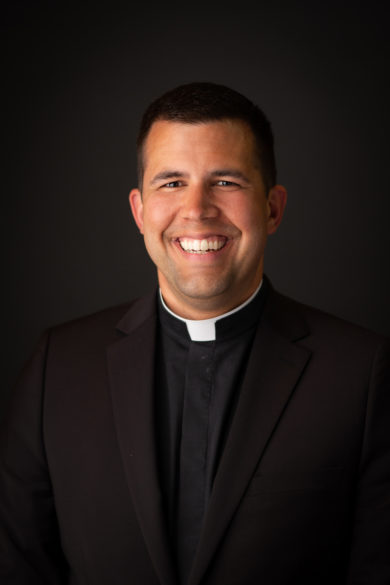
The human dimension is the “everyday” dimension of the man. What habits/character traits/virtues of a candidate create a bridge between himself and his flock as he helps to lead them to the Lord? What habits/character traits/vices create a stumbling block? This is the most basic part of priestly formation, and the human dimension is developed with the most basic of requirements in the seminary. Do you wake up on time for prayer? Are you pleasant at the breakfast table? What are your conversation skills? Are you comfortable speaking with someone who is much older/younger than you?
Everyone will be at a different stage of development when they enter the seminary, but we all have traits that we can hone and develop as we seek to better relate to our surroundings. I believe that one of the most important traits that a man seeking priesthood must have is self-awareness. If we are humbly aware of our struggles and imperfections and we are honest about them, then we can move forward in peace and really seek to find the Lord in that struggle for improvement, but if we seek to hide our flaws from others and act like they are not there, then this is a recipe for misery, both for ourselves or those around us.
The seminary is a place where honest and open communication about human formation is encouraged. Seminarians are encouraged to “fraternally correct” their peers if they witness a human formation issue themselves. Candidates regularly meet with a formation adviser who serves as a mirror for the man as he lives in the community, and yearly self-evaluations and faculty evaluations provide updates on progress. Human formation, however, continues for a lifetime. We are all called to be (as Bishop Robert Barron would term it) “great-souled,” men and women who are open to others and serve as witnesses to Christ’s love in the world. Human formation in the seminary provides many practical tools for men to be good, well-adjusted and helpful priests, but that work must continue beyond ordination.
By Junno Arocho
VATICAN CITY (CNS) – Before baptizing 16 babies in the Sistine Chapel, Pope Francis reminded parents and godparents of their responsibility to care for and preserve the Christian identity the infants were about to receive.
“This is your task throughout your lives: to guard the Christian identity of your children,” the pope said. “It is a daily commitment: help them grow with the light they receive today.”
The pope baptized the seven boys and nine girls – the children of Vatican employees – in the Sistine Chapel during the celebration of Mass Jan. 9, the feast of the Baptism of the Lord.
The annual tradition of baptizing infants on the feast day, which began in 1981 by St. John Paul II, was canceled last year due to the pandemic.
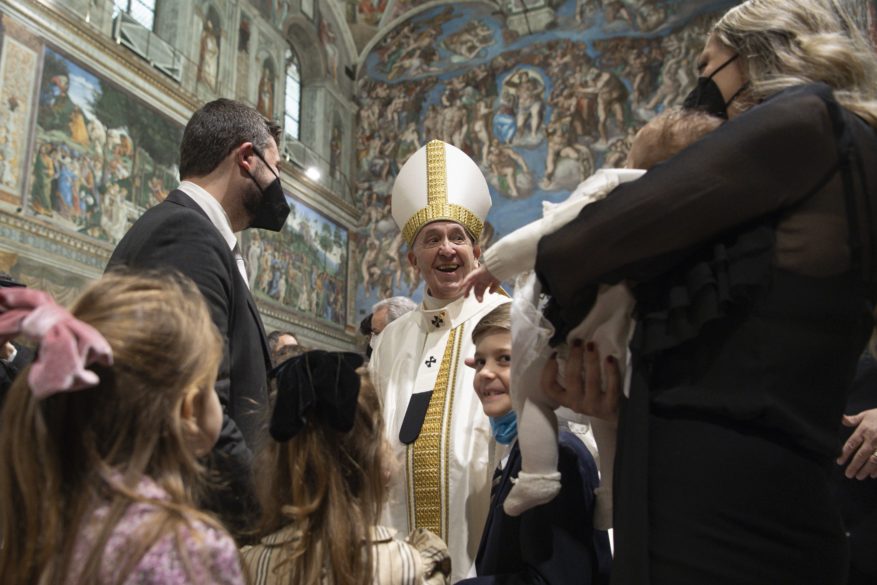
Although the baptisms resumed this year, the number of infants was significantly reduced. In January 2020, the pope had baptized 32 infants in the Sistine Chapel.
Delivering a brief, off-the-cuff homily, Pope Francis recalled a hymn for the feast day that said the people of Israel went to the Jordan River to be baptized “with bare feet and bare souls.”
“These children today also come here with ‘bare souls’ to receive God’s justification, Jesus’ strength, the strength to move forward in life,” he said. “Your children will receive their Christian identity today. And you, parents and godparents, must guard this identity.”
With the sounds of fussy children filling the frescoed chapel, the pope repeated his usual advice to mothers of infants, encouraging them to make their children comfortable, and to not worry if they start to cry in the chapel.
“This ceremony is a bit long, the children then feel uncomfortable here in an environment they do not know. Please, they are the protagonists: make sure that they are not too hot, that they feel comfortable,” Pope Francis said.
“If they are hungry, breast feed them here, in front of the Lord, no problem,” he added. “And if they cry out, let them cry out, because they have a community spirit, let’s say a ‘band spirit,’ a spirit of ensemble, and all it takes is for one to start – because everyone is musical – and immediately the orchestra comes! Let them cry, let them feel free.”
Follow Arocho on Twitter: @arochoju
IN EXILE
By Father Ron Rolheiser, OMI
Recently NASA launched the James Webb Space Telescope into space, the biggest and most expensive telescope ever built. It will take six months for it to travel a million miles from the earth, find its permanent place in space, and then start transmitting pictures back to earth. Those pictures will be such as have never seen before. The hope is that it will enable us to see much further into space than we’ve ever seen before, ideally to the very ends of our still expanding universe, right to the first particles that issued forth from the original explosion, the Big Bang, that began time and our universe.
Scientists estimate that our universe began 13.7 billion years ago. As far as we know, prior to that there was nothing in existence, as we understand that today (except for God). Then, out of this seeming nothingness, there was an explosion (the Big Bang) out of which everything in the universe including our planet earth formed. As with any explosion, the parts that were the most intimately intertwined with the expelling force are those driven furthest away. Thus, when investigators try to determine the cause of an explosion they are particularly interested in finding and examining those pieces that were most closely tied to the original force of the explosion, and generally those pieces have been blown furthest away.
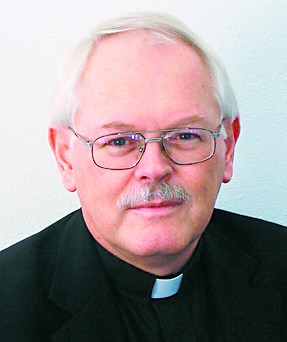
The force of the Big Bang is still going on and those parts of our universe that were most intimately intertwined with its beginnings are still being driven further and further into space. Scientists are investigators, probing that original explosion. What the James Webb Space Telescope hopes to see is some of the original parts from that unimaginable explosion that gave birth to our universe because these parts were there at the very beginning, at the origins of everything that exists. By seeing and examining them, science hopes to better understand the origins of our universe.
Looking at the excitement scientists feel around this new telescope and their hopes that it will show us pictures of particles from the beginning of time, can help us understand why the Evangelist, John, has trouble restraining his enthusiasm when he talks about Jesus in his first Epistle. He is excited about Jesus because, among other things, Jesus was there at the beginnings of the universe and indeed at the beginnings of everything. For John, Jesus is a mystical telescope through which we might view that primordial explosion that created the universe, since he was there when it happened.
Let me risk paraphrasing the beginning of the First Epistle of John (1:1-4) as he might have written it for our generation vis-a-vis our curiosity about the origins of our universe:
You need to understand of whom and what I am speaking:
Jesus wasn’t just some extraordinary person who performed a few miracles or even who rose from the dead.
We are speaking of someone who was there at the very origins of creation, who himself is the foundation for that creation, who was with God when “the Big Bang” occurred, and even before that.
Incredibly, we actually got to see him in the flesh, with human eyes, the God who created “the Big Bang,” walking among us!
We actually touched him bodily.
We actually spoke with him and listened to him speak, he who was there at the origins of our universe, there when “the Big Bang” took place!
Indeed, he is the One who pulled the switch to set it off, with a plan in mind as to where it should go, a plan that includes us.
Do you want to probe more deeply into what happened at our origins?
Well, Jesus is a mystical telescope to look through.
After all, he was there at the beginning and unbelievably we got to see, hear, and touch him bodily!
Excuse my exuberance, but we got to walk and talk with someone who was there at the beginning of time.
There are different kinds of knowledge and different kinds of wisdom, along with different avenues for accessing each of them. Science is one of those avenues, an important one. For far too long theology and religion did not consider it a friend. That was (and remains) a tragic mistake since science has the same founder and same intent as theology and religion. Theology and religion have been wrong whenever they have sought to undercut science’s importance or its claims to truth. Sadly, science has often returned the favor and viewed theology and religion as a foe rather than as a colleague. The two need each other, not least in understanding the origins and intent of our universe.
How do we understand the origins and intent of our universe? Science and Jesus. Science is probing those origins in the interest of telling us how it happened and how it is unfolding, while Jesus (who was there when it happened) is more interested in telling us why it happened and what it means.
(Oblate Father Ron Rolheiser is a theologian, teacher and award-winning author. He can be contacted through his website www.ronrolheiser.com.)
By Richard Meek The Catholic Commentator
CHATAWA – Nestled in a stunningly beautiful corner of southwest Mississippi, Our Lady of Hope Retreat Center features 400 acres of Mother Nature’s finest work.
Far removed from a main highway, or even a small town, the rolling property offers a welcome tranquility, a place where deer roam freely, where native woods house species of every sort, where a picturesque lake featuring a gazebo and a canoe are the center’s welcome mat.
For Father Mark Beard it is a 400-acre answer to a prayer. A Catholic retreat center serving the Diocese of Baton Rouge has been a dream of his for several years but as he said “didn’t think it would ever come to fruition.”

He and Ponchatoula businessman Mike Fulmer had been seeking to purchase property suitable for a retreat center and believed they had found the ideal setting when the former Rosaryville Center went up for sale. Ultimately, the Dominican Sisters of Peace sold the retreat center to a businessman and it has since been turned into a non-denominational center.
Fulmer later learned St. Mary of the Pines in Chatawa, Mississippi was on the market. Originally opened by the School Sisters of Notre Dame in 1874 as an all-girls boarding school, the facility, which was used as a retreat center in later years, had become too burdensome for the sisters to continue to manage.
“When (Fulmer) called (regarding a visit to Chatawa) I think my first words were, ‘Mike I don’t think we can afford to go down one more rabbit hole,’” Father Beard recalled with a chuckle.
But he relented and during his initial tour Father Beard knew God was revealing his dream before his eyes with each passing step. But he had one more surprise coming when earlier this year the property was sold to an individual who then donated the property to Chatawa Retreat Center, a non-profit business which manages the facility.
“That was manna from heaven,” Father Beard said.
The School Sisters of Notre Dame had had the property listed for close to three years and fielded offers but it remained unsold. Fortunately, the buildings needed little work, a tribute to the sisters who Father Beard said “operated on a shoestring.”
The sprawling property features a combined 100,000 square feet of living areas, while Rosaryville had 10,000 square feet. Additionally, Our Lady of Hope has two dorms that can accommodate more than a combined 100 retreatants, a main dining room along with smaller dining rooms, a chapel that once served as a parish church, an outdoor Stations of the Cross, a firepit, cafeterias and beautiful vistas throughout.
A well-stocked gift shop includes paintings and digital copies of paintings of Drazen Vucina, an artist from Medjugorje, where Father Beard found his calling to be a priest. Our Lady of Hope features more than 50 of Drazen’s original works.
Improvements include turning the property’s oldest building, a storage area built in 1875, into a eucharistic adoration chapel.
Father Beard said all retreat centers offer the same amenities, such as good food and nice beds but what will ultimately separate Our Lady of the Hope are plans for 13 individual gardens that will include a Mary Garden and a garden of the apostles.
Father Beard admitted to some trepidation to opening the center during the COVID-19 pandemic, thinking “Really, Lord?’ Could we have picked a worse time to get started?”
Despite those concerns, success has come early. Already, the center has hosted several retreats, ranging from one day to a week. Other groups, such as ACTS, a production company and high schools have utilized the facility.
Also under discussion is four Catholic high schools who wish to host a four-team basketball tournament with the emphasis on the retreat component.
“It’s kind of hard to sell it until you come and visit it,” Father Beard acknowledged.
In the past few months he has visited the chaplains and youth ministers at the Catholic schools in New Orleans. He followed with personal invitations and open houses.
Father Beard has also made visits to schools in Mississippi and Alabama and a Lake Charles company recently took drone photography for the website.

“A lot of (the marketing) is personal; you need to meet the people and say ‘I need you to come visit,’“ he said.
Exuding an enthusiasm that is contagious, Father Beard discussed his vision for the future, which includes the potential of opening an elementary school that might be more “home schoolish” in the beginning.
Plans also call for building two tiny houses tucked away in the woods away from the center where clergy members can come spend a night or two to enjoy the solitude, to pray, to unwind. Father Beard cited the challenges of being a diocesan priest, saying that 20% percent is spent on the theological side of issues and the remaining 80% on such matters as building facilities maintenance, upkeep and meetings.
“You are not in the theology world and you can see it on the priests,” he said. “They are exhausted and his will give them a chance to get away and to be alone.”
For now, Father Beard roams the grounds frequently, checking on the status of projects, or more important checking on his dream.
“I love it,” he said. “I love the quiet. I love only to have to talk about our faith. We want to pass Catholicity through the door to as many people as we can.”
For information on Our Lady of Hope and how to book a retreat visit www.ourladyofhopems.com.
By Joanna Puddister King
JACKSON – As the Diocese of Jackson kicks off the 2022 Catholic Service Appeal (CSA), Rebecca Harris paused to remember all that has changed in our world and our lives over the past 24 months.
“We remember that our Catholic faith has been there in these trying times. Let us find comfort in the Eucharist knowing that Jesus is guiding each of us. He has been our ‘Hope Rising,'” said Harris.
Each year in January Bishop Joseph Kopacz sends letters to all parishioners in the diocese asking for support of 11 ministries that are vital to the Catholic faith.
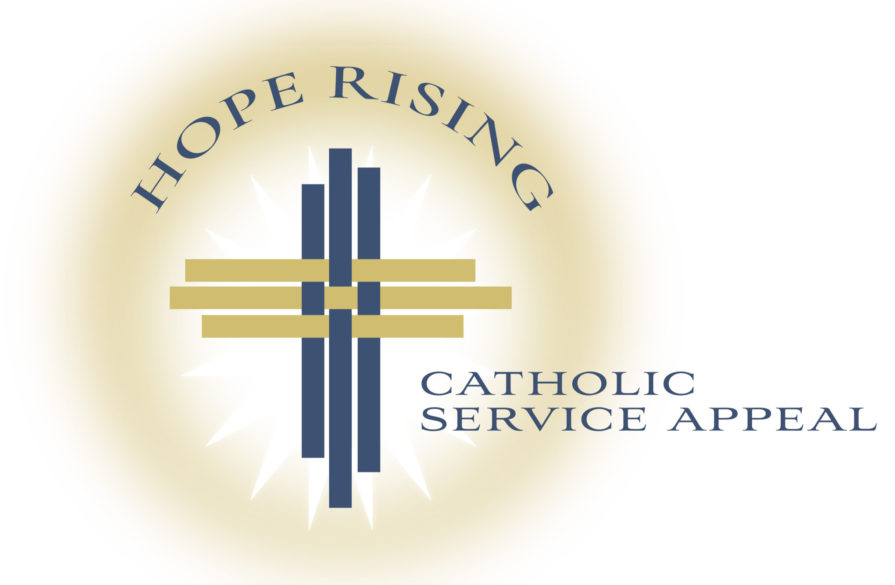
“When you make a gift you become the ‘Hope Rising’ to those served by the appeal,” Harris says.
The Catholic community can become the hope to those served by these ministries: Seminarian Education, Catholic Schools, Retired Priests, Catholic Charities, Campus Ministry, Formation Ministry and Religious Education, Intercultural Ministry, Evangelization and Communication, Family Ministry, Youth Ministry and Parishes.
For detailed information on each of these ministries supporters can visit website csa.jacksondiocese.org.
Harris says that supporters will also find stories from people who have been supported by the Catholic Service Appeal.
“This year, we are featuring stories that show a small piece of how donations to the CSA make huge impacts.”
Supporters can click on the “Voices” page to see how donations supported Izzy from the Catholic Charities Unaccompanied Refugee Minor program; or learn how the Pastoral Ministry Retreat supports Letty Ruiz as a catechist at her parish. Site visitors can also hear how the vocations ministry supported Kathleen McMullan as she answered the call of God; and discover how Father P.J. Curley is supported through donations to retired priests. And lastly, read how youth ministry supports Carrie Lambert and the youth of her parish at St. Mary Basilica in Natchez.
“Let us reflect, remember and renew all those who are served by the ministries supported by the Catholic Service Appeal. With your gift you are our ‘Hope Rising,'” says Bishop Joseph Kopacz.
There are several ways to give to the 2022 Catholic Service Appeal. Pledge cards can be mailed to PO Box 22723; Jackson, MS 39225; supporters can visit csa.jacksondiocese.org to donate online; or text to give at 601-706-5858.
Gifts of stocks can also be made to support the CSA. For more information on the CSA, contact Rebecca Harris at (601) 960-8477.
From the hermitage
By sister alies therese
In England I was blessed to know an Anglican priest, Robert Llewelyn, who for many years was the chaplain at the Julian Shrine in Norwich. I lived some twenty miles away and went there frequently. Of his several books, a favorite is Prayer and Contemplation (SLG Press, Oxford, 1977). In chapter seven, he considers contemplation and the cloud of forgetting – some help to me.
As we age forgetfulness shows up … names, things, why I’m doing this, where was I going? etc. These seem quite negative and often cause us to wonder where we are on the dementia continuum.
I heard about a psychiatrist speaking before a group of seniors about dementia. Key to his rather clinical explanations was this delightful indicator. He asked how many had lost their keys. Most raised their hands. Then he asked how many found them? Most raised their hands. That is not dementia he told them. This is: did you know what to do with the keys when you found them? This caused some laughter and he laughed too. Holy forgetting is not quite the same!
This holy forgetting that Robert writes about is from The Cloud of Unknowing an old 14th century text, written by the author to a young disciple who wanted training in prayer. These ‘clouds’ help us focus on God in prayer. For example, one of the most important things to put under this cloud of forgetting is past sins, confessed and forgiven. Yes, they come into our minds … that distracts us. In Chapter 31 of The Cloud:
“…sins (new or old) try to cover them with the thick cloud of forgetting as though they had never been committed by you or anyone else …”
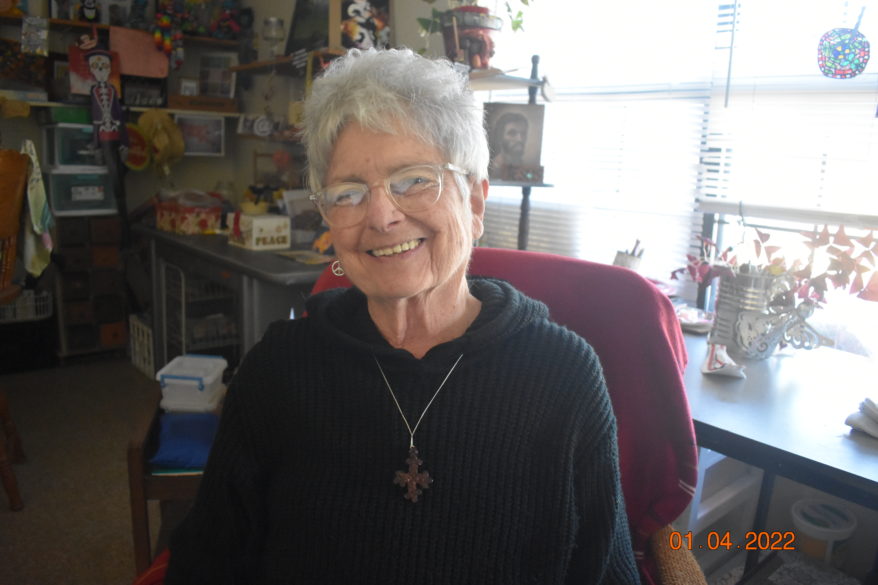
Robert then goes on to remind us that he is not talking about repression (nor was the author of The Cloud) … that is dangerous. “That,” he says, “is a compulsory and involuntary forgetting or experience of memories which the mind has found too painful to retain in conscious thought.” These are mental health issues to be sorted and healed in other ways.
Robert is concerned rather with trying to heal involuntary distractions (and even voluntary ones), so that we are able to pray, focused on God. “We are,” he says, “poor apart from God’s enabling strength and it may well be that this awareness is our deepest need.” (page 80)
Without this strength we can do nothing. Our goal is to ultimately behold God and in our daily life we see the many wonderful, unique, and marvelous works of God … but not quite God. What we want, Robert reminds us, is to come to the prayer of the Holy Spirit who “gives us the ‘best’ prayer, whether seen as being for God’s glory or as a meeting of our need for deliverance: twin aspects of prayer that must be held together.”
“But once our sights,” he concludes, “have been truly set on God, with the desire and intention that in God’s grace they will remain so, we need not fear these invaders of our imagination. What now becomes necessary is to pay them no attention.” When this is practiced, we find healing. “Try to forget created things, let them go … sit in the darkness as long as it takes … go on longing after the God you love, never giving up.”
Mark Lowry, Christian humorist, musician and writer noted this: “I look forward … but the memories can be greater.” He talks of how his PawPaw couldn’t remember much near his end … “except the Sunday dinners on the ground and singing in the male quartet. He sat and looked forward to the coming of the Lord … where memories and plans are the same. And I’m sure,” he quips, “over the door into heaven there is a sign: No Wheelchairs, Hospital Beds, or Bedpans Allowed!” Great things to forget!
(Sister alies therese is a canonically vowed hermit with days formed around prayer and writing.)